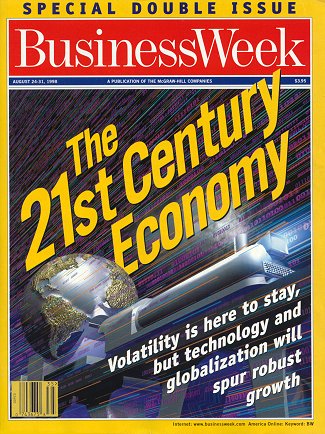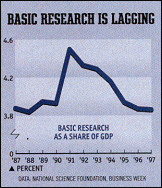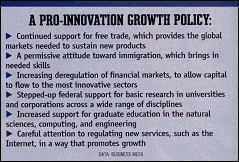
Why the Pace Has To Pick Up
To sustain growth of at least 3%, increased savings must be combined with a big jump in basic research
 From: Business Week, August 24-31, 1998
From: Business Week, August 24-31, 1998
By Michael J. Mandel
Nobody can fault the U.S. economy's performance over the past few years. Strong growth, falling inflation, low unemployment, and a rising stock market have combined to make this the best economy in at least 30 years. Now what remains is the biggest qu estion of all: how to keep the economy on the fast track, growing at 3% or more a year well into the 21st century. Most economists believe that the best way to increase long-term growth is to boost national savings by cutting the budget deficit or changin g the tax system to discourage consumption. The benefits of encouraging savings are simple and easy to understand: Increased savings means lower interest rates more investment in new machinery and buildings, and ultimately, a MOre productive economy. "It' s pretty foolproof," says Martin Feldstein of Harvard University, who also heads the National Bureau of Economic Research. "Once you start building up additional savings, almost all of it will end up in investment."
But the growth payoff of a policy focused solely on increasing savings to keep the economy in high gear is small. The proudest achievement of Washington policymakers - the elimination of the federal budget deficit, which went as high as $290 billion in 1992 - will add only 0.1 percentage point to the annual growth rate over the next 10 years, according to most econometric estimates. Similarly, the controversial proposal to privatize Social Security will boost savings by requiring deposits into personal retirement accounts. That, too, however, will give only a slight lift to average growth.
In the 21st Century Economy, it's innovation that will give us the growth spurt we need, not prudence and a budget surplus. And that has always been true. All the evidence suggests that a pro-innovation policy produces high returns. Historically, inves tment in research and development has yielded at least a 30% annual return to society, compared with an 8% to 10% return on investment in physical capital, such as new machines. Today, the U. S.'s private and public sectors together spend about $200 billi on a year on research and development, and that's a lot of money. But with the rate of return on R&D SO high compared with other investments, the country should be spending a lot more. According to a 1997 paper by Charles I. Jones of Stanford University a nd John C. Williams of the Federal Reserve, the right level of U. S. spending on R&D iS "more than four times larger than actual spending."
 SAVINGS OR INNOVATION? A pro-innovation economic policy would be very different than one designed to encourage savings. In principle, it might seem that a country as rich as U.S. could do both at once. But in reality they require almost diametrica lly opposed policies. For one, savings and innovation compete for national resources, since one key way to boost national savings is to reduce the federal budget deficit. Each billion not spent on defense or health care, for instance, means less governmen t borrowing, lower interest rates, and more private-sector investment. But when many other pressing needs are being cut back to reduce spending, it's hard for Congress to find more funds for R&D.
SAVINGS OR INNOVATION? A pro-innovation economic policy would be very different than one designed to encourage savings. In principle, it might seem that a country as rich as U.S. could do both at once. But in reality they require almost diametrica lly opposed policies. For one, savings and innovation compete for national resources, since one key way to boost national savings is to reduce the federal budget deficit. Each billion not spent on defense or health care, for instance, means less governmen t borrowing, lower interest rates, and more private-sector investment. But when many other pressing needs are being cut back to reduce spending, it's hard for Congress to find more funds for R&D.
Equally important, savings and innovation each require a very different psychology. The way to get people to save more is to encourage prudence and frugality - to instill anxiety about the future. By contrast, innovation is more likely to come out of a willingness to take risks and an optimism about future possibilities. It is no coincidence that Japan - a cautious society par excellence, with a national savings rate about twice that of the U. S. - has in recent years struggled to match the innovations coming out of entrepreneurial companies in the U.S.
Now, to keep the economy growing, Washington policymakers need to take a step in a different direction: an economic policy with a top priority of encouraging innovation. In part, that means paying more attention to how federal policies can deleteriousl y affect the high-tech industry in such areas as regulating the Internet, visa quotas for high-tech workers, and encryption policy (page 140).
What will be more difficult is finding a good way to get more funds into basic research and graduate science education. It won't be easy. Many economists and politicians are leery of putting more taxpayer dollars into encouraging innovation, and with s ome good reason. During much of the postwar period, the government had a terrible track record in directing innovation. Notable - and expensive - examples include the space program, nuclear power, and the synthetic-fuels program started by President Jimmy Carter in 1979. These programs were essentially funded and directed by the government, and while some scored notable technical successes, none has produced major economic payoffs. Indeed, despite the remarkable technical achievement of landing a man on t he moon, the only important economic uses of space today are satellite communications and satellite imaging. From an economic perspective, that's a comparatively small payoff from the more than $200 billion spent on space R&D since the early 1960s.
 Moreover, the experience of the 1970s and 1980s has biased economists against counting on "innovation policy" as a way out of economic stagnation. During those decades, technological progress apparently added little to economic growth. That's why a saving s-oriented growth policy - no matter how slow - seemed like the only game in town.
Moreover, the experience of the 1970s and 1980s has biased economists against counting on "innovation policy" as a way out of economic stagnation. During those decades, technological progress apparently added little to economic growth. That's why a saving s-oriented growth policy - no matter how slow - seemed like the only game in town.
But the technological pessimism of the previous two decades was overdone. Innovation is once again driving the economy, and it will continue to do so in the future. In that kind of an economy, maintaining or boosting R&D iS essential.
There's a paradox, however: Studies show that an R&D dollar spent by the private sector or in academics has a much bigger payoff than research done in government-run labs. Yet left to their own devices, corporations will naturally focus on doing R&D th at translates directly into profitable products. The more fundamental work of scientific discovery - the kind of research that has tremendous benefits for society as a whole - is uneconomical for individual companies, with a few rare exceptions.
RISKY BUSINESS. That's true even in high tech: Despite their explosive growth and high profits, most information-technology companies focus their R&D dollars on short-term issues, such as getting out the next generation of chips or software. Mea nwhile, the critical long-term issues of the reliability and productivity of software are not receiving enough attention. "We have much less money available for the kind of high-risk research investment that really tries to intersect with the future," says Kenneth W. Kennedy, a computer-science professor at Rice University who is co-chair of the presidential advisory committee on high-performance computing.
Since 1991, private and public spending on basic research as a share of gross domestic product has fallen sharply (chart, page 136). That trend needs to be reversed, especially since corporations are focusing their R&D funds more and more on applicatio ns related directly to their businesses. The first priority, therefore, is to increase funding for basic research, which provides the underlying foundation for future technological progress.
That suggests that the government has an important role in funding long-term basic research. And historically, that is where government funds have done the most good. Much of the early work on the transistor and integrated circuits was funded by the De fense Dept. Remember, too, that the Internet was initially spawned by government money. And these are hardly the only examples. "The things funded 10 to 15 years ago produced a large portion of the stream of ideas that created the cu rrent generation of technology," says Kennedy.
Moreover, government-funded basic research has a multiplier effect by spurring additional funding by the private sector. According to a June, 1998, report by the generally skeptical Congressional Budget Office, "federally sponsored science, particularl y that conducted in academia, does indeed play a 'bird dog' role in the economy." Corporations use the basic research conducted by academics as a guide to the profitable areas to explore. "Most of the exciting work is done at universities," says Nathan My hrvold, chief technology officer at Microsoft Corp.
But not every dollar has an equal impact. For one thing, a portion of the money now going to government-run national laboratories each year should be gradually shifted to the private sector, where it will probably have a bigger payoff - or the labs sho uld be required to devote more resources to solving business and industrial problems. Equally important, the government agencies in charge of handing out funds, such as the National Science Foundation and the National Institutes of Health, should resist t he temptation to pick winners and losers. Or even trying to guess which areas are going to have the biggest payoff should be a low-level priority. Instead, government agencies should concentrate on nurturing a diversified portfolio of research grants in a wide range of areas, from cutting-edge biotech to such mundane areas as construction.
Right now, government funding is not diversified enough. Outside of defense and space, about half of all federal R&D dollars are spent on health-related research. While that focus has helped produce the biotech revolution, there are key areas that are underfunded. The point is not to cut back on health-related research but to add to the other areas.
Boosting basic research is only part of what's needed, however. The other critical area that must be beefed up is the supply of trained scientists and engineers. Surprisingly, for an age of innovation, there are signs that the educational system has no t kept up with the growing needs of the economy. "We're hurting badly, worldwide, for knowledge workers to support the industry," observes Richard M. Levy, chairman of the American Electronics Assn. and executive vice-president of Varian Associates Inc.
The sag in science education must be reversed. At a time when businesses are gasping for skilled workers, enrollment in science and engineering programs - especially at the graduate level - has been dropping. That suggests that the government should bo ost funding for graduate students in critical technological fields. "Technology doesn't just fall from the heavens like the rain," says Alan S. Blinder, the Princeton University economist who has served on President Clinton's Council of Economics Advisors and as vice-chairman of the Federal Reserve. "If you're serious about accelerating growth, the two levers are human-capital formation and R&D."
 Part of the problem is that there are too many other opportunities for college grads to make money. For example, 10 years ago, colleges were graduating about 40,000 computer-science majors per year. Now that number is down to 25,000. Total enrollment in g raduate science and engineering programs has dropped for three years in a row, as high pay for high-tech workers makes it more appealing to get a job instead of going to graduate school. In the short run, that's the right thing to do, but it's the equival ent of eating your seed corn: It reduces the number of people working on the basic research needed for years hence.
Part of the problem is that there are too many other opportunities for college grads to make money. For example, 10 years ago, colleges were graduating about 40,000 computer-science majors per year. Now that number is down to 25,000. Total enrollment in g raduate science and engineering programs has dropped for three years in a row, as high pay for high-tech workers makes it more appealing to get a job instead of going to graduate school. In the short run, that's the right thing to do, but it's the equival ent of eating your seed corn: It reduces the number of people working on the basic research needed for years hence.
What should be done? More fellowship dollars must be found to encourage students to pursue engineering and the sciences. Moreover, the money for graduate students should not be tied to particular research projects, because that makes it hard for gradua te students to adjust to changes in a hot field. "If you put the money into the hands of the bright young people, they will respond to private-sector opportunities," says Paul Romer of Stanford University.
OPEN SYSTEMS Maintaining a healthy private sector is crucial. In fact, one of the top priorities for the U. S. is to sustain its current open financial system, which can quickly shift resources to innovative sectors. Venture capital, initial pub lic offerings, and junk bonds enable new ideas to get funded relatively easily, while lagging companies are punished by being taken over or bought out. By contrast, the Japanese financial system can provide companies with very cheap capital through its in terlocking networks of banks and corporate ties. The trade-off is an enormous amount of rigidity and inflexibility. "The strategies that Japan and other countries use to reduce the cost of capital are inimical to innovation," says Romer.
Similarly, a commitment to free trade and relatively open immigration is an essential part of a pro-innovation policy. The pressure from foreign competitors forces U. S. companies to look for new and better ways of doing things. And skilled immigrants hav e fueled America's high-tech surge.
From this perspective, Washington policymakers can justifiably take credit for a decade of very good economic policy that helped lay the groundwork for the innovative surge of the 1990s. Despite heated criticism from both the left and the right, two fr ee-trade agreements, the North American Free Trade Agreement and the General Agreement on Tariffs & Trade, were approved by a Democratic and Republican Congress, respectively, and signed by a Democratic President. Policy, by itself, can guarantee a new age of innovation. And just as a seed grows better in the right soil, forward-looking policies create a better environment in which bright ideas can flourish.
By Michael J. Mandel in New York
Sites & Affiliations | Leadership | Research & Applications | Major Accomplishments | FAQ | Search | Knowledge & Technology Transfer | Calendar of Events | Education & Outreach | Media Resources | Technical Reports & Publications | Parallel Computing Research Quarterly Newsletter | News Archives | Contact Information
| Hipersoft | CRPC |
© 2003 Rice University
|